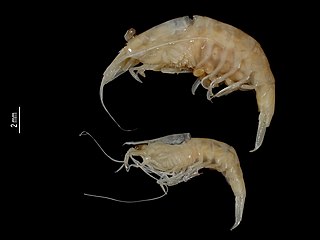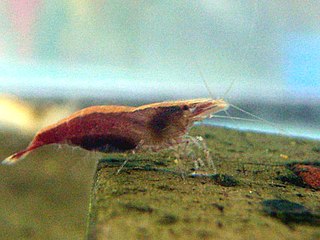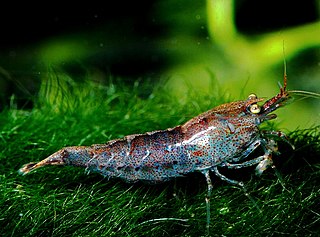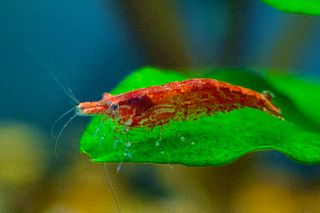 W
WAtyidae is a family of shrimp, present in all tropical and most temperate waters of the world. Adults of this family are almost always confined to fresh water. This is the only family in the superfamily Atyoidea.
 W
WThe Alabama cave shrimp is a species of shrimp in the family Atyidae, found only in caves in the state of Alabama.
 W
WAtya is a genus of freshwater shrimp of the family Atyidae, ranging through the Antilles and along the Atlantic and Pacific slopes of Central and South America and in western Africa. It contains the following species:Atya abelei Felgenhauer & Martin, 1983 Atya africana Bouvier, 1904 Atya brachyrhinus Hobbs & Hart, 1982 Atya crassa (Smith, 1871) Atya dressleri Abele, 1975 Atya gabonensis Giebel, 1875 Atya innocous (Herbst, 1792) Atya intermedia Bouvier, 1904 Atya lanipes Holthuis, 1963 Atya limnetes Holthuis, 1986 Atya margaritacea A. Milne-Edwards, 1874 Atya ortmannioides Villalobos, 1956 Atya scabra (Leach, 1815)
 W
WAtya gabonensis is a species of freshwater shrimp from West Africa and South America. It is an omnivorous filter feeder that uses feather-like claspers to filter particles from the water. It can grow to 15 centimetres. It has many common names, including African fan shrimp, African filter shrimp, African giant shrimp, vampire shrimp, blue rhino shrimp, Gabon shrimp, and Cameroon fan shrimp.
 W
WAtya lanipes is a freshwater amphidromous shrimp of the Atyidae family in the Decapoda order. It is found widely in the Caribbean and is common in the Toro Negro State Forest in central Puerto Rico. It is also known as jonga and in some places people refer to it as "guábara” or “chágara”.
 W
WAtya scabra is a species of freshwater shrimp in the family Atyidae. Atya scabra can reach a length of about 89 millimetres (3.5 in) in males, while females are generally smaller, reaching about 64 mm (2.5 in). It lives on rocky bottoms in rivers connected to the Atlantic Ocean. The species is widespread from Mexico to Brazil, Jamaica, Hispaniola, and Puerto Rico. In Africa, it occurs from Liberia to Angola, the Cape Verde Islands and the islands of the Gulf of Guinea.
 W
WAtyopsis is a genus of freshwater shrimp from Southeast Asia. It was erected in 1983 by Fenner A. Chace, Jr. for two species formerly treated in the genus Atya. It differs from Atya by various characters, including the form of the telson and the presence of a "massive spur" on the male third pereiopod.
 W
WCaridina cantonensis, the bee shrimp, is a species of small freshwater shrimp in the family Atyidae. It is native to Taiwan. These shrimp are scavengers, and eat small pieces of decayed vegetation and algae. Bee shrimp have a life span of about 18 months. They enjoy a temperature in the 70 to 78 °F range. Many modern versions of bee shrimp are selectively bred for their characteristics.
 W
WSyncaris pacifica is an endangered species of freshwater shrimp in the family Atyidae that occurs only in a limited range within the northern San Francisco Bay Area, California, USA. Specifically, this species occurs only in 17 stream segments within Sonoma, Napa and Marin Counties. This species is often translucent to transparent, with both sexes capable of considerable coloration altering, as a sophisticated form of camouflage. This decapod is commonly known as California freshwater shrimp, and is the only decapod shrimp in California that occurs in non-saline waters.
 W
WCaridina is a genus of freshwater atyid shrimp. They are widely found in tropical or subtropical water in Asia, Oceania and Africa. They are filter-feeders and omnivorous scavengers. They range from 0.9–9.8 mm to 1.2–7.4 mm in carapace length.
 W
WCaridina cantonensis, the bee shrimp, is a species of small freshwater shrimp in the family Atyidae. It is native to Taiwan. These shrimp are scavengers, and eat small pieces of decayed vegetation and algae. Bee shrimp have a life span of about 18 months. They enjoy a temperature in the 70 to 78 °F range. Many modern versions of bee shrimp are selectively bred for their characteristics.
 W
WCaridina cantonensis var. blue tiger or blue tiger shrimp is a variety of freshwater shrimp from Southeast Asia that are popular in hobby aquariums. The natural coloration of the shrimp is blue of varying intensity, with black "tiger" stripes along its body. Variations of the species may also have orange eyes, and orange highlights in the tail fins.
 W
WCaridina dennerli is a small species of freshwater shrimp from Sulawesi (Indonesia) that grows up to 2.5 centimetres (1.0 in) in length. It takes its name from the German company Dennerle, which supported the expedition that led to the scientific description of the species. It is popularly known as the 'Cardinal Shrimp' in the aquarium trade.
 W
WCaridina gracilirostris is a species of brackishwater shrimp belong to genus Caridina in the family Atyidae. It has a wide native range extending from Japan and Fiji through Indonesia to Madagascar. It is an algae-eating species that lives in mangroves and marshes. Its common names include red front shrimp, red rhinoceros shrimp, red nosed phantom shrimp, and needlenose caridina, red nosed shrimp.
 W
WCaridina linduensis is a species of freshwater shrimp in the family Atyidae, endemic to Lake Lindu and its effluent stream in Sulawesi. It was known only from the type series, collected in 1904, and was recorded again in 2011 in a survey around Lake Lindu and is found in shallow littoral habitats of leaf litter, macrophytes, and dead wood. In the effluent stream it is found on soft substrates and slow flowing water, and is less common in the lake itself. The type locality of Lake Lindu was designated as a Recreation Park in 1978, and is part of the larger Lore Lindu National Park and UNESCO Biosphere Reserve. It is listed under IUCN criterion B1ab(iii,v) as Critically Endangered due to threats from introduced species of fish, land conversion to agriculture, logging, and shore disturbance caused by the grazing of water buffalo. Surveys are required to find the full distribution of C. linduensis, primarily its habitat in the effluent stream. C. linduensis is also sympatric with the recently described species Caridina dali and Caridina kaili.
 W
WCaridina loehae is a freshwater shrimp from Sulawesi. It is known as mini blue bee and orange delight shrimp in the aquarium trade. It is endemic to the Malili lake system. It lives on rocky substrates at a maximal depth of 5 metres.
 W
WCaridina multidentata is a species of shrimp in the family Atyidae. It is native to Japan and Taiwan. Its common names include Yamato shrimp, Japanese shrimp, Amano shrimp, and algae shrimp.
 W
WCaridina nilotica is a species of freshwater shrimp in the family Atyidae. It is native to Africa from the River Nile in Egypt to Lake Sibaya, South Africa, and is the only species of shrimp in Lake Victoria.
 W
WCaridina serratirostris is a species of freshwater shrimp that lives in the Indo-west Pacific region, from Madagascar to Fiji, including northern Queensland, Australia, which may be a different subspecies. Its common name in the aquarium trade, "ninja shrimp", comes from its ability to quickly change colour and disappear into its surroundings like a ninja. Adults grow to a length of 25–35 millimetres (1.0–1.4 in).
 W
WCaridina simoni is a freshwater shrimp found widespread in Sri Lanka and Tamil Nadu, India. The Indian population was originally described as Caridina kunnathurensis by Richard & Chandran in 1994, but was later identified to be the same species. It is found in a diversity of habitats, including both rivers and lakes.
 W
WCaridina thambipillai is a species of freshwater shrimp in the family Atyidae. It is native to Malaysia and Myanmar, where it occurs in streams. It is a common crustacean of the freshwater aquarium trade, where it is known as the Sunkist shrimp.
 W
WCaridina woltereckae, or Sulawesi harlequin shrimp as it is commonly known in the aquarium hobby, is a freshwater shrimp from Sulawesi, Indonesia. It is endemic to Lake Towuti. It resembles the smaller and less contrastingly coloured Caridina spongicola, which is endemic to the same lake.
 W
WThe golden bee shrimp is a species of shrimp found in southern China, including Hong Kong . It is one of many varieties of Bee shrimp.
 W
WHalocaridina is a genus of atyid shrimp. It contains two species – Halocaridina rubra and Halocaridina palahemo – both endemic to Hawaii. H. rubra is widely kept in aquaria.
 W
WHalocaridina rubra, the Hawaiian red shrimp or volcano shrimp is a small red shrimp of the family Atyidae, with the common Hawaiian name ʻōpaeʻula.
 W
WThe Kentucky cave shrimp is an eyeless, troglobite shrimp. It lives in caves in Barren County, Edmonson County, Hart County and Warren County, Kentucky. The shrimp's shell has no pigment; the species is nearly transparent and closely resembles its nearest relative, the Alabama cave shrimp.
 W
WNeocaridina is a genus of atyid shrimp, containing the following species:
 W
WNeocaridina davidi is a freshwater shrimp from Taiwan which is commonly kept in aquaria. The natural coloration of the shrimp is green-brown. There are a wide range of colors such as red, yellow, orange, green, blue, violet, black, etc., however, the red morph is more frequently sold. The density of coloration on adult shrimp, dependent on breeding, determines their sale price and "quality" (grading). This "quality" is purely aesthetic, as the size, behavior and other characteristics of the animal is more or less equal across varieties. Full-grown shrimp reach about 4 centimetres (1.6 in) long. They prefer clean water, with a pH of 6.5-8, and a temperature of 14–29 °C (57–84 °F) They are most comfortable at 22 °C (72 °F). N. davidi shrimp are omnivores that may live 1–2 years. These shrimp have previously been classified as Neocaridina heteropoda and Neocaridina denticulata sinensis, however are now known as Neocaridina davidi which is based on the oldest known published description of the species.
 W
WNeocaridina palmata is a freshwater shrimp found in China and Vietnam. It is found in rivers, streams and ponds. Their preferred habitat is heavily planted, slow flowing water.
 W
WNeocaridina zhangjiajiensis, known as the pearl shrimp in the aquarium hobby, is a freshwater shrimp. Multiple breeds were bred in Germany for the aquarium trade.
 W
WThe genus Palaemonias comprises two species of endangered, albinistic, obligate cave shrimp:Alabama cave shrimp – Palaemonias alabamae Smalley, 1961 Kentucky cave shrimp – Palaemonias ganteri Hay, 1901
 W
WThe Alabama cave shrimp is a species of shrimp in the family Atyidae, found only in caves in the state of Alabama.
 W
WThe Kentucky cave shrimp is an eyeless, troglobite shrimp. It lives in caves in Barren County, Edmonson County, Hart County and Warren County, Kentucky. The shrimp's shell has no pigment; the species is nearly transparent and closely resembles its nearest relative, the Alabama cave shrimp.
 W
WStygiocaris is a genus of shrimp from caves in the North West Cape and Barrow Island, Western Australia.
 W
WSyncaris pacifica is an endangered species of freshwater shrimp in the family Atyidae that occurs only in a limited range within the northern San Francisco Bay Area, California, USA. Specifically, this species occurs only in 17 stream segments within Sonoma, Napa and Marin Counties. This species is often translucent to transparent, with both sexes capable of considerable coloration altering, as a sophisticated form of camouflage. This decapod is commonly known as California freshwater shrimp, and is the only decapod shrimp in California that occurs in non-saline waters.
 W
WTroglocaris is a genus of freshwater shrimp in the family Atyidae. These stygobitic, whitish and eyeless shrimp are found in Southern Europe. Although locally very common, the small ranges of the individual species make them highly vulnerable to habitat loss, for example by water extraction. Their underground habitat is often extremely stable; for example, the Vipavska jama cave in Slovenia is home to a population of T. anophthalmus, and its water only varies from 10 °C (50 °F) in the winter to 11 °C (52 °F) in the summer. In some Dinaric caves, notably Vjetrenica, as many as three species may occur together.